六年级英语语法知识点整理
(完整版)六年级英语语法知识点汇总

六年级语法总复习亠、词汇(一)一般过去时态一般过去时态表示在过去的某个时间发生的动作或存在的状态,常和表示过去的时间状语连用。
例如yesterday, last weeke nd ,last Saturday , 等连用。
基本句型:主语+动词的过去式+其他。
例句---------- What did youdo last weekend? 你上周做什么了?---- I played football last weeke nd. 我踢足球了。
★规则动词过去式的构成1. 一般在动词原形末尾加-ed。
例如:play —played2. 词尾是e的动词直接加-d。
例如:dance —da need3. 末尾只有一个辅音字母的重读闭音节词,先双写这个辅音字母,再加-ed。
例如stop (停止)--stopped4. 结尾是“辅音字母+y ”的动词,变“ y”为“ i”,再加-ed,例如:study-studied★ 一些不规则变化的动词过去式am/is —was are —were go -—went swim-—swamfly —flew do —did have —had say —-saidsee—sawtake —took come —came become —became get—got draw—drew hurt—-hurtread —read tell —told will—would eat — ate take —took make —made drink —drank sleep(睡觉)—slept cut (切)--cut sit(坐)—satbegin(开始)—began th ink —thought find —found run(跑)---ra n buy —bought win -—won give(给)—gave sing —sang leave —left hear (听)--heart wear ——wore(二)一般现在时态一般现在时态表示包括现在时间在内的一段时间内经常发生的动作或存在的状态,表示习惯性或客观存在的事实和真理。
六年级英语语法知识点.doc
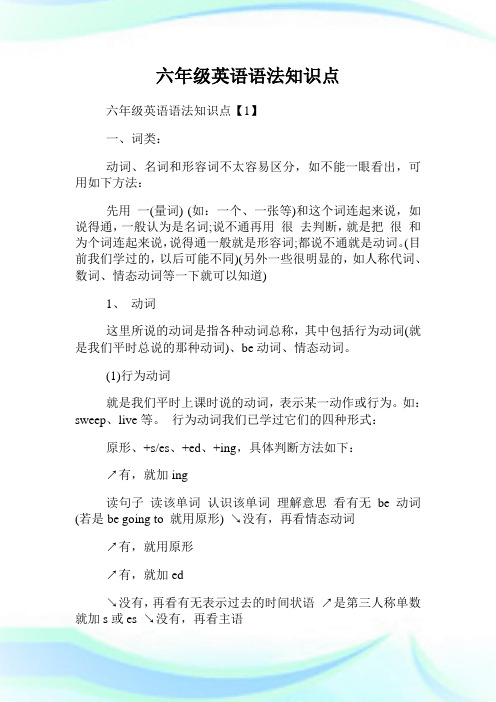
六年级英语语法知识点六年级英语语法知识点【1】一、词类:动词、名词和形容词不太容易区分,如不能一眼看出,可用如下方法:先用一(量词) (如:一个、一张等)和这个词连起来说,如说得通,一般认为是名词;说不通再用很去判断,就是把很和为个词连起来说,说得通一般就是形容词;都说不通就是动词。
(目前我们学过的,以后可能不同)(另外一些很明显的,如人称代词、数词、情态动词等一下就可以知道)1、动词这里所说的动词是指各种动词总称,其中包括行为动词(就是我们平时总说的那种动词)、be动词、情态动词。
(1)行为动词就是我们平时上课时说的动词,表示某一动作或行为。
如:sweep、live等。
行为动词我们已学过它们的四种形式:原形、+s/es、+ed、+ing,具体判断方法如下:↗有,就加ing读句子读该单词认识该单词理解意思看有无be动词(若是be going to 就用原形) ↘没有,再看情态动词↗有,就用原形↗有,就加ed↘没有,再看有无表示过去的时间状语↗是第三人称单数就加s或es ↘没有,再看主语↘不是第三人称单数就用原形(2)be动词a、Am--was Is --was Are--were 口诀:我用am, 你用are, is 用在他她它,所有复数全用are。
b、肯定和否定句I am (not) from London. He is(not) a teacher. She is(not) in the dining room. My hair is(not) long. Her eyes are(not) small.c、一般疑问句Am I a Chinese? Yes, you are. No, you aren t. Are they American? Yes, they are. No, they aren t. Is the cat fat? Yes, it is. No, it isn t.我们现在学过的be动词大致分两类:is、am、are为一类,一般用于一般现在时、现在进行时和一般将来时中,was和were 为另一类,一般用于一般过去时。
六年级语法知识点大全

六年级语法知识点大全一、句子结构在语法中,句子是指能够独立表达完整意思的一组词。
句子可以分为简单句、复合句和并列句。
1. 简单句简单句由一个主语和一个谓语构成,可以用来表达一个完整的意思。
例句:Tom is playing football.2. 复合句复合句由一个主句和一个或多个从句构成,从句可以充当名词、形容词或副词。
例句:I will go to the park if it doesn't rain tomorrow.3. 并列句并列句由两个或多个句子用连词连接而成,在并列句中,各个句子的地位相同,彼此之间没有从属关系。
例句:I like to play basketball, and my sister likes to play tennis.二、主谓一致主谓一致是指主语和谓语在人称和数上要保持一致。
1. 单数主语+单数谓语例句:The cat is sleeping.2. 复数主语+复数谓语例句:The cats are playing.三、时态时态指的是动词在时间上的变化形式。
英语中常见的时态有一般现在时、一般过去时和一般将来时。
1. 一般现在时一般现在时用于表示经常性或普遍性的动作或状态。
例句:She eats breakfast every morning.2. 一般过去时一般过去时用于表示过去发生的动作或状态。
例句:I visited my grandparents last weekend.3. 一般将来时一般将来时用于表示将来要发生的动作或状态。
例句:We will have a party tomorrow.四、形容词和副词的比较级和最高级形容词和副词可以用来比较不同事物的大小、程度或性质。
1. 比较级比较级用于比较两个事物的大小、程度或性质,形容词的比较级通常在词尾加"-er"或在前面加"more",副词的比较级通常在词尾加"-er"或在前面加"more"。
六年级语法知识点总结英语
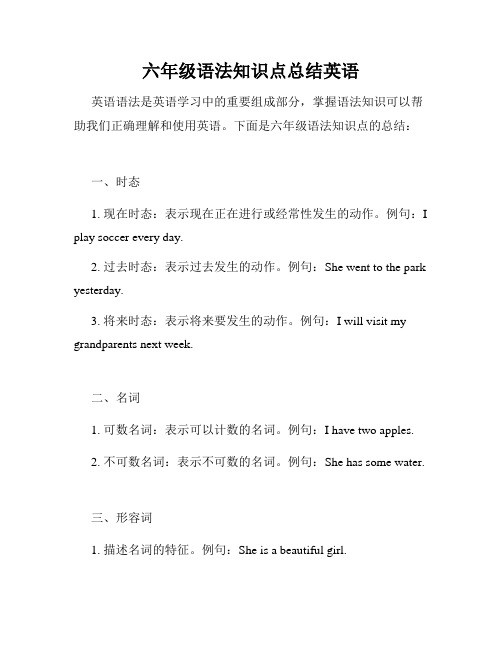
六年级语法知识点总结英语英语语法是英语学习中的重要组成部分,掌握语法知识可以帮助我们正确理解和使用英语。
下面是六年级语法知识点的总结:一、时态1. 现在时态:表示现在正在进行或经常性发生的动作。
例句:I play soccer every day.2. 过去时态:表示过去发生的动作。
例句:She went to the park yesterday.3. 将来时态:表示将来要发生的动作。
例句:I will visit my grandparents next week.二、名词1. 可数名词:表示可以计数的名词。
例句:I have two apples.2. 不可数名词:表示不可数的名词。
例句:She has some water.三、形容词1. 描述名词的特征。
例句:She is a beautiful girl.2. 形容词的比较级和最高级:用于比较两个或多个事物之间的差异。
例句:She is taller than her brother.四、副词1. 描述动词或形容词的特征。
例句:He runs quickly.2. 表示时间、地点、方式等。
例句:She lives here.五、代词1. 人称代词:用来代替人或事物。
例句:He is my friend.2. 物主代词:表示所属关系。
例句:This is his book.六、动词1. 动词的时态:表示动作的发生时间。
例句:I am reading a book now.2. 动词的语态:表示动作的主动或被动关系。
例句:The book is written by the author.七、连词1. 表示并列关系的连词:例句:She likes playing soccer and swimming.2. 表示选择关系的连词:例句:Do you want tea or coffee?八、介词1. 表示位置、时间、方向等。
例句:He is in the park.2. 表示目的、原因等。
六年级英语语法知识点汇总.doc
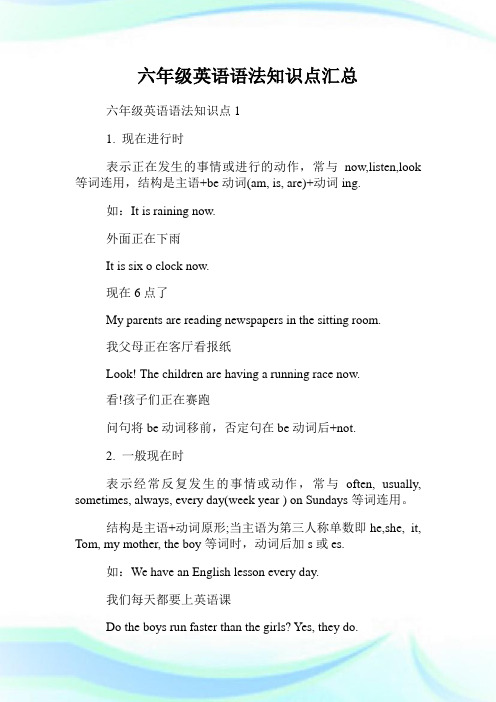
六年级英语语法知识点汇总六年级英语语法知识点11. 现在进行时表示正在发生的事情或进行的动作,常与now,listen,look 等词连用,结构是主语+be动词(am, is, are)+动词ing.如:It is raining now.外面正在下雨It is six o clock now.现在6点了My parents are reading newspapers in the sitting room.我父母正在客厅看报纸Look! The children are having a running race now.看!孩子们正在赛跑问句将be动词移前,否定句在be动词后+not.2. 一般现在时表示经常反复发生的事情或动作,常与often, usually, sometimes, always, every day(week year ) on Sundays等词连用。
结构是主语+动词原形;当主语为第三人称单数即he,she, it, Tom, my mother, the boy等词时,动词后加s或es.如:We have an English lesson every day.我们每天都要上英语课Do the boys run faster than the girls? Yes, they do.男孩比女孩跑的快吗?是的问句借助于do, does否定句借助于don t, doesn t,后面动词一定要还原。
3. 一般过去时表示发生在过去的事情或存在的状态,常与just now; a moment ago; ago; yesterday; last ( week; month; year; Monday; weekend); this morning等词连用。
结构是主语+be动词的过去式(was; were)或主语+动词的过去式。
注意:be动词与动词过去式不可同时使用。
如:My earphones were on the ground just now.我的耳机刚刚还在呢。
六年级英语必会语法知识点

六年级英语必会语法知识点英语作为一门语言,它的语法规则是我们学习英语不可或缺的一部分。
对于六年级的学生来说,掌握英语的基本语法知识点对于提高语言表达能力至关重要。
本文将重点介绍六年级英语必会的语法知识点,帮助学生们更好地理解和运用英语语法。
一、动词时态1. 一般现在时:表示经常性或普遍性的动作或状态。
常用的标志词有often, usually, always等。
例句:I often go to the park on weekends.2. 现在进行时:表示正在进行的动作。
常用的标志词有now, at the moment等。
例句:She is studying in the library right now.3. 一般过去时:表示过去发生的动作或状态。
常用的标志词有yesterday, last week等。
例句:We watched a movie last night.4. 过去进行时:表示过去某一时刻正在进行的动作。
常用的标志词有at that time, when等。
例句:She was sleeping when I called her.5. 一般将来时:表示将来要发生的动作或状态。
常用的标志词有tomorrow, next week等。
例句:They will visit their grandparents this weekend.二、形容词和副词的比较级和最高级1. 比较级:表示两个人或物之间的比较。
形容词和副词的比较级通常在词尾加-er。
例句:This book is longer than that one.2. 最高级:表示三个或三个以上人或物之间的比较。
形容词和副词的最高级通常在词尾加-est。
例句:She is the tallest girl in her class.三、名词的单数和复数形式1. 名词的复数形式通常在词尾加-s,但也有一些特殊的变化规则。
例句:My friend has many books.2. 部分名词的复数形式是不规则的,需要进行记忆。
六年级英语语法知识点汇总
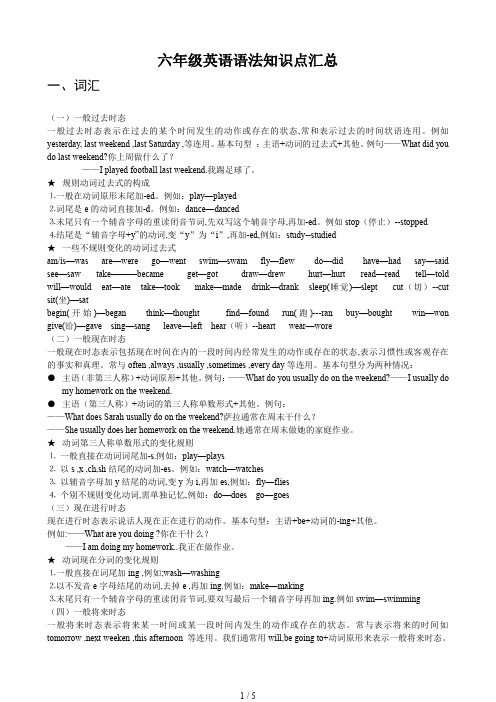
六年级英语语法知识点汇总一、词汇(一)一般过去时态一般过去时态表示在过去的某个时间发生的动作或存在的状态,常和表示过去的时间状语连用。
例如yesterday, last weekend ,last Saturday ,等连用。
基本句型:主语+动词的过去式+其他。
例句——What did you do last weekend?你上周做什么了?——I played football last weekend.我踢足球了。
★规则动词过去式的构成⒈一般在动词原形末尾加-ed。
例如:play—played⒉词尾是e的动词直接加-d。
例如:dance—danced⒊末尾只有一个辅音字母的重读闭音节词,先双写这个辅音字母,再加-ed。
例如stop(停止)--stopped⒋结尾是“辅音字母+y”的动词,变“y”为“i”,再加-ed,例如:study--studied★一些不规则变化的动词过去式am/is—was are—were go—went swim—swam fly—flew do—did have—had say—said see—saw take———became get—got draw—drew hurt—hurt read—read tell—told will—would eat—ate take—took make—made drink—drank sleep(睡觉)—slept cut(切)--cut sit(坐)—satbegin(开始)—began think—thought find—found run(跑)---ran buy—bought win—won give(给)—gave sing—sang leave—left hear(听)--heart wear—wore(二)一般现在时态一般现在时态表示包括现在时间在内的一段时间内经常发生的动作或存在的状态,表示习惯性或客观存在的事实和真理。
小学六年级英语必须要掌握的语法知识点(完美版)
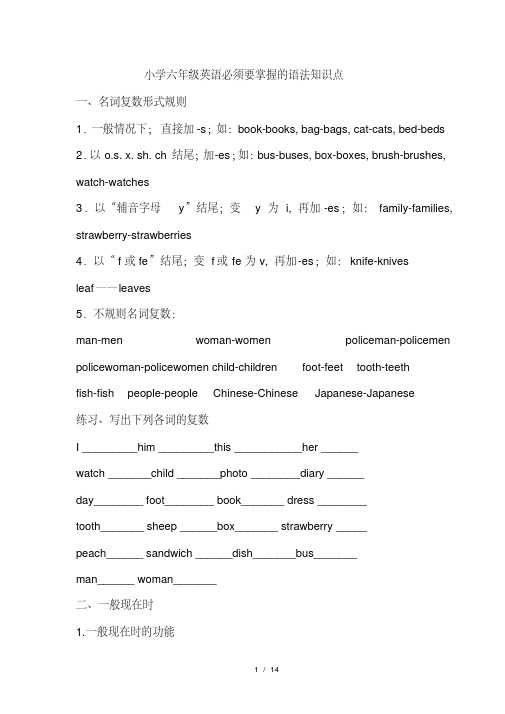
小学六年级英语必须要掌握的语法知识点一、名词复数形式规则1.一般情况下;直接加-s;如:book-books, bag-bags, cat-cats, bed-beds 2.以o.s. x. sh. ch结尾;加-es;如:bus-buses, box-boxes, brush-brushes, watch-watches3.以“辅音字母y”结尾;变y为i, 再加-es;如:family-families, strawberry-strawberries4.以“f或fe”结尾;变f或fe为v, 再加-es;如:knife-knives leaf——leaves5.不规则名词复数:man-men woman-women policeman-policemen policewoman-policewomen child-children foot-feet tooth-teethfish-fish people-people Chinese-Chinese Japanese-Japanese练习、写出下列各词的复数I _________him _________this ___________her ______watch _______child _______photo ________diary ______day________ foot________ book_______ dress ________tooth_______ sheep ______box_______ strawberry _____peach______ sandwich ______dish_______bus_______man______ woman_______二、一般现在时1.一般现在时的功能○1表示事物或人物的特征、状态.如:The sky is blue.天空是蓝色的.○2表示经常性或习惯性的动作.如:I get up at six o’clock every day.我天天六点起床.○3表示客观现实.如:The earth goes around the sun.地球绕着太阳转.2.一般现在时的构成○1肯定句: a. be动词:(有一顺口溜体现了它的用法:我用am ;你用 are ;is 用于他;她;它, 单数is;复数are..)主语+ be(am /is/are)+其他如: I am a boy.我是一个男孩.b.行为动词(实义动词):主语+行为动词+其他[除主语是第三人称单数外;都用动词原形;当主语是第三人称时;则在行为动词词尾加-s或-es.]如:We study English.我们学习英语.She goes to work by bike. 她骑自行车去上班.○2否定句: a.主语+ be(am /is/are) +not + 其他如: I am not a boy.b. 主语+don't/doesn't+行为动词原形+其他如:We don’t study English. She doesn't go to work by bike.○3一般疑问句: a. Be(Am /Is /Are)+ 主语+ 其他?简略回答: (肯) Yes,主语 + be(am /is/are). (否) No,主语 + be(am /is/are)+not.如: Are you a boy?你是一个男孩吗?(肯)Yes,I am. (否) No, I’m not.b. Do/Does+主语+ 其他?简略回答: (肯) Yes,主语+ do/does. (否) No,主语 + don't/doesn't.如: Do you study English? (肯)Yes,we do. (否) No, we don’t. - Does shego to work by bike? - Yes, she does. / No, she doesn't.○4特殊疑问句:特殊疑问词+一般疑问句?如: a. be动词:Who are you?b.行为动词:What do you do? How does she go to work?3.动词三单的变化规则(即“如何从动词原形变为第三人称单数”)○1一般情况下;直接加-s;如:cook-cooks get-gets○2以o.s.x.sh.ch结尾,直接加-es;如:wash-washes, watch-watches, go-goes○3以“辅音字母y”结尾;变y为i, 再加-es;如:study-studies一般现在时用法专练:一、写出下列动词的第三人称单数drink ________ go _______ stay ________ make ________look _________ have_______ pass_______ carry ____________study_______ brush________ do_________ teach_______wash_______二、用括号内动词的适当形式填空.1. He often ________(have) dinner at home.2. Daniel and Tommy _______(be) in Class One.3. We _______(not watch) TV on Monday.4. Nick _______(not go) to the zoo on Sunday.5. ______ they ________(like) the World Cup?6. What _______they often _______(do) on Saturdays?7. _______ your parents _______(read) newspapers every day?8. The girl _______(teach) us English on Sundays.9. She and I ________(take) a walk together every evening.10. There ________(be) some water in the bottle.11. Mike _______(like) cooking.12. They _______(have) the same hobby.13. My aunt _______(look) after her baby carefully.14. You always _______(do) your homework well.m staying in bed.15. I _______(be) ill. I’16. She _______(go) to school from Monday to Friday.17. Liu Tao _______(do) not like PE.18. The child often _______(watch) TV in the evening.19. Su Hai and Su Yang _______(have) eight lessons this term.20. -What day _______(be) it today? -It’s Saturday三、现在进行时1.现在进行时表示现在正在进行或发生的动作;也可表示当前一段时间内的活动或现阶段正在进行的动作.2.现在进行时的构成:be+动词的ing〔现在分词〕形式.肯定句:主语+be动词+动词ing+其他.如:We are studying.否定句:主语+be动词+not+动词ing+其他.如:We aren’t studying.一般疑问句:Be动词+主语+动词ing+其他.如:Are you studying?肯定回答:Yes+主语+be动词.如:Yes,we are.否定回答:No+主语+be动词+not.如:No,we aren’t.;但是am not在;are not可以缩写成aren’t(注:is not可以缩写成isn‘t现代英语中不可以缩写.)特殊疑问句:特殊疑问词+一般疑问句?如:What are you doing?现在分词的变化规则1.一般情况下;直接加ing;如:cook-cooking think---thinking2.以不发音的字母e结尾的单词,去掉字母e;再加ing 如:make-making have---having3.以重读闭音节(重读闭音节即两个辅音中间夹一个元音并且重读的音节)结尾;呈现“辅;元;辅”结构的动词;双写末尾的辅音字母;再加ing 如: stop---stopping sit---sitting run---running4 以ie结尾的动词;把ie改为y ;再加ing die---dying lie---lying现在进行时专项练习:一、写出下列动词的现在分词:play________ run__________ swim _________make__________go_________ like________ write________ study__________read________ have_________ sing ________ dance_________put_________ see________ buy _________ love____________stop_________ sit ________ begin________ shop___________二、用所给的动词的正确形式填空:1.The boy __________________ ( draw)a picture now.2. Listen .Some girls _______________ ( sing)in the classroom .3. My mother _________________ ( cook )some nice food now.4. What _____ you ______ ( do ) now?5. Look . They _______________( have) an English lesson .6.They ____________(not ,water) the flowers now.7.Look! the girls ________________(dance )in the classroom .8.What is our granddaughter doing? She _________(listen ) to music.ow. We _____________(have)supper now9. It’s 5 o’clock n10.______Helen____________(wash )clothes? Yes ,she is .四、一般将来时一、概念:表示将要发生的动作或存在的状态及打算、计划或预备做某事.句中一般有以下时间状语:tomorrow, next day(week, month, year…),soon, the day after tomorrow(后天)等.二、基本结构:肯定句: a. 主语+shall/will+do+其他.(will可用于所有人称;shall只用于第一人称I和we) 如: I will go swimming tomorrow.b. 主语+ be going to + do+其他.(注意:be 动词要与主语的人称和数一致)如:I am going to go swimming tomorrow.否定句:a. 主语+shall/will+not+do(will not 可缩写成won’t)b. 主语+ be+ not+ going to +do 如:I won’t go swimming tomorrow. I am not going to go swimming tomorrow.一般疑问句:a. Shall/Will+主语+ do+其他? b. Be+主语+going to+do+其他?如:Will you go swimming tomorrow? Are you going to go swimmingtomorrow?特殊疑问句:特殊疑问词+一般疑问句?如:What will you go tomorrow? What are you going to do tomorrow?练习填空.1. 我打算明天和朋友去野炊.I_____ _______ _________ have a picnic with my friends.I ________ have a picnic with my friends.2.我们将要学习英语We _____ _______ _________ learn English.We ________ learn English.五、一般过去时1.一般过去时表示过去某个时间发生的动作或存在的状态;常和表示过去的时间状语连用,如:yesterday;yesterday morning;yesterday afternoon;yesterday evening;the day before yesterday(前天);last night;last week;last month; last year等. 一般过去时也表示过去经常或反复发生的动作.2.一般过去式的基本结构:Be动词在一般过去时中的变化:⑴am 和is在一般过去时中变为was.(was not=wasn’t)⑵are在一般过去时中变为were.(were not=weren’t)○1肯定句:主语+动词过去式+其他.如:I was in Shanghai last month.上个月我在上海.We went to Shanghai last month.我们上个月去了上海.○2否定句:a主语+wasn’t/weren’t+其他.如: I wasn’t in Shanghai last month.b. 主语+didn’t+动词原形+其他.(did + not = didn't)如:We didn’t go to Shanghai last month.○3一般疑问句: a.Was/Were+主语+其他?如:Were you in Shanghai last month?b. Did+主语+动词原形+其他?如:Did you go to Shanghai last month? ○4特殊疑问句:特殊疑问词+一般疑问句?如:Where were you last month? Where did you go last month?动词过去式变化规则:1.一般情况下;在动词原形后面加-ed;如:look→looked play→played start→started visit→visited2.以不发音e结尾的动词;在词尾直接加-d;如: live→lived use→used 3.以“辅音字母+ y”结尾的动词;先将 y 改为i ,再加–ed;如: study →studied, try→tried fly→flied4.以重读闭音节(即辅音+元音+辅音)或r音节结尾;末尾只有一个辅音字母的动词;要先双写这个辅音字母后;再加–ed;如: stop→stopped plan→planned5.不规则动词过去式:练习一、写出下列动词的过去式is/am_________ plant________ are ________drink_________ play_______ go________ make ________does_________ dance________ worry________ ask _____taste_________ eat__________ put ______kick_________ pass_______ do ________练习二、用be动词的适当形式填空1. I _______ at school just now.2. He ________ at the camp last week.3. We ________ students two years ago.4. They ________ on the farm a moment ago.5. Yang Ling ________ eleven years old last year.6. There ________ an apple on the plate yesterday.7. There ________ some milk in the fridge on Sunday.8. The mobile phone _______ on the sofa yesterday evening.练习三、用所给动词的适当形式填空1. I ______ (watch) a cartoon on Saturday.2. Her father _______ (read) a newspaper last night.3. We _________ to zoo yesterday, we _____ to the park. (go)4. ______ you _______ (visit) your relatives last Spring Festival?5. ______ he _______ (fly) a kite on Sunday? Yes, he ______.6. Gao Shan _______ (pull) up carrots last National Day holiday.7. I ____________ (sweep) the floor yesterday, but my mother ______.8. What ______ she _______ (find) in the garden last morning? She__________ (find) a beautiful butterfly.六、人称代词和物主代词第一人称第二人称第三人称单数复数单数复数单数复数人称代词主格I we you you she he it they 宾格me us you you her him it them物主代词形容词性my our your your her his its their 名词mine ours yours yours hers his its theirs人称代词指代人或物;在句中作主语或宾语;所以有主格和宾格.宾格代词用于替代处于宾语位置上的名词;可以用作直接宾语和间接宾语. 如:I am a student. (I 主语) Please help me. (me 直接宾语) Give me a book. (me 间接宾语)物主代词是表示所有关系的一种代词;亦称所有格代词.物主代词有两种形式:形容词性物主代词和名词性物主代词.形容词性物主代词为限定词;放在名词或名词短语前作定语.如:This is my book.名词性物主代词起名词的作用;后面不可以再接名词.在句子中可以作主语、宾语或表语.如: Your pen is red. Mine is black.你的钢笔是红色的,我的是黑色的.He didn’t use his ink. He used mine.他没有用他自己的墨水;他用了我的.习题一、用所给词的适当形式填空1. That is not _________ kite. That kite is very small, but _________ isvery big. ( I )2. The dress is _________. Give it to _________. ( she )3. Is this _________ watch? (you) No, it’s not _________ . ( I )4. _________ is my brother. _________ name is Jack. Look! Those stamps are _________. ( he )二、用am, is, are 填空1. I ______ a boy. ______ you a boy? No, I _____ not.2. The girl______ Jack's sister.3. The dog _______ tall and fat.4. The man with big eyes _______ a teacher.5. ______ your brother in the classroom?6. Where _____ your mother? She ______ at home.7. How _______ your father?8. Mike and Liu Tao ______ at school.9. Whose dress ______ this?10. Whose socks ______ they?七、形容词、副词的比较级和最高级(一)构成规则1.一般单音节词和少数以-er;-ow结尾的双音节词;比较级在后面加-er;最高级在后面加-est(1)单音节词如:small→smaller→smallest short→shorter→shortest (2)双音节词如:clever→cleverer→cleverest narrow→narrower→narrowest2.以不发音e结尾的单音节词;比较在原级后加-r;最高级在原级后加-st 如:large→larger→largest nice→nicer→nicest3.在重读闭音节(即:辅音+元音+辅音)中;先双写末尾的辅音字母;比较级加-er;最高级加-est;如:big→bigger→biggest hot→hotter→hottest fat→fatter→fattest4.以“辅音字母+y”结尾的双音节词;把y改为i;比较级加-er;最高级加-est如:easy→easier→easiest heavy→heavier→heaviest busy→busier→busiest happy→happier→happiest5.其他双音节词和多音节词;比较级在前面加more;最高级在前面加most如:beautiful→more beautiful→most beautiful different→more different→most different easily→more easily→most easily注意:(1)形容词最高级前通常必须用定冠词 the;副词最高级前可不用. 如: The Sahara is the biggest desert in the world.(2)形容词most前面没有the;不表示最高级的含义;只表示"非常". It is a most important problem. =It is a very important problem.6.有少数形容词、副词的比较级和最高级是不规则的;必须熟记. 如:good→better→best well→better→best bad→worse→worst ill→worse→worst old→older/elder→oldest/eldest many/much→more→most little→less→least far →further/farther→ furthest/farthest(二)形容词、副词的比较级和最高级的用法1.“A + be +形容词比较级 + than + B”意思为“A比B更,,”.如:This tree is taller than that one. 这棵树比那棵树高.注意:①在含有连词than的比较级中;前后的比较对象必须是同一范畴;即同类事物之间的比较.②在比较级前面使用much;表示程度程度“强得多”.如:A watermelon is much bigger than an apple.③ very, quite一般只能修饰原级;不能修饰比较级.2.“比较级 + and + 比较级”或“more and more +原级”表示“越来越,,”如:It is getting cooler and cooler. 天气越来越凉爽.3.在含有or的选择疑问句中;如果有两者供选择;前面的形容词要用比较级形式.如:Who is taller,Tim or Tom? 谁更高;Tim还是Tom?4. “the +比较级..., the+比较级”;表示“越...越...”.如: The sooner;the better. 越快越好.习题一、出下列形容词、副词的原级;比较级;最高级small→→→fatter→hot→________ →________ thin→________→ _________heavy→________ →________ bad→________→ _________习题二、用适当形式填空:1. Bob is ________ ( young ) than Fred but __________ (tall) than Fred2. Yingtian is not as ___________ (tall) asYongxian.3. Almost all the students' faces are the same but Li Deming looks ____ ___ (fat) than before .4. Which is _________ (heavy), a hen or a chicken?5.-- How _________ (tall) is Sally?-- She' s 1.55 metres ________ (tall). What about Xiaoling? -- She' s only 1.40 metres ______ (tall). She is much _______(short) than Sally. She is also the _______ (short)girlin theclass.。
英语所有语法知识点六年级

英语所有语法知识点六年级一、动词时态1. 一般现在时:用于表示经常性或普遍性的动作、情况或状态例句:I play football every Sunday.2. 一般过去时:用于表示过去某个时间发生的动作或状态例句:She watched a movie yesterday.3. 一般将来时:用于表示将来要发生的动作或情况例句:I will visit my grandparents next week.4. 进行时态:用于表示正在进行的动作例句:They are eating lunch now.5. 完成时态:用于表示已经完成的动作或状态例句:He has finished his homework.二、名词1. 可数名词与不可数名词例句:There are three apples on the table. (可数名词) I want some water. (不可数名词)2. 单数名词与复数名词例句:The dog is cute. (单数名词)The dogs are playing in the park. (复数名词)3. 名词所有格例句:Tom's book is on the table.三、形容词与副词1. 形容词用于修饰名词,表示名词的性质、特征或状态例句:She has a beautiful flower.2. 副词用于修饰动词、形容词或副词,表示方式、程度或时间等例句:He runs quickly.四、冠词1. 不定冠词(a/an)用于泛指单数可数名词前例句:I see an apple.2. 定冠词(the)用于特指或泛指某个人或物例句:The cat is on the table.五、代词1. 主格代词用于作主语例句:She is my friend.2. 宾格代词用于作宾语例句:He gave me a present.3. 物主代词表示所属关系例句:This is his book.六、介词1. 介词用于表示位置、时间、原因、方式等例句:He is in the park.2. 一些常见介词:in, on, at, with, for, to 等七、连词1. 并列连词用于连接同等重要的词、短语、句子等例句:I like apples and oranges.2. 从属连词用于引导从句例句:She is happy because she won the game.八、疑问词1. 疑问词用于构成疑问句例句:Where is the book?九、形容词比较级与最高级1. 形容词比较级用于表示两者之间的比较例句:She is taller than her sister.2. 形容词最高级用于表示三者或三者以上的比较例句:She is the tallest girl in the class.十、情态动词1. 情态动词用于表示能力、可能性、许可等例句:I can swim.十一、直接引语与间接引语1. 直接引语直接引述别人的原话例句:He said, "I am happy."2. 间接引语是对别人的话进行转述例句:He said he was happy.以上是六年级英语的所有语法知识点,掌握这些知识将会帮助你更好地理解和运用英语语法。
六年级英语语法知识点知识总结
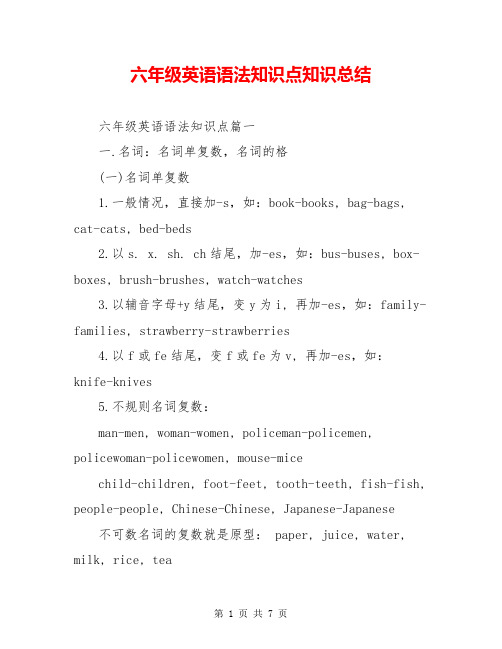
六年级英语语法知识点知识总结六年级英语语法知识点篇一一.名词:名词单复数,名词的格(一)名词单复数1.一般情况,直接加-s,如:book-books, bag-bags, cat-cats, bed-beds2.以s. x. sh. ch结尾,加-es,如:bus-buses, box-boxes, brush-brushes, watch-watches3.以辅音字母+y结尾,变y为i, 再加-es,如:family-families, strawberry-strawberries4.以f或fe结尾,变f或fe为v, 再加-es,如:knife-knives5.不规则名词复数:man-men, woman-women, policeman-policemen, policewoman-policewomen, mouse-micechild-children, foot-feet, tooth-teeth, fish-fish, people-people, Chinese-Chinese, Japanese-Japanese 不可数名词的复数就是原型: paper, juice, water, milk, rice, tea六年级英语语法知识点篇二(一)、形容词的比较级1、形容词比较级在句子中的运用:两个事物或人的比较用比较级,比较级后面一般带有单词than。
比较级前面可以用more, alittle来修饰表示程度。
than后的人称代词用主格(口语中可用宾格)。
2.形容词加er的规则:⑴ 一般在词尾加er ;⑵ 以字母e 结尾,加r ;⑶ 以一个元音字母和一个辅音字母结尾,应双写末尾的辅音字母,再加er ;⑷ 以辅音字母+y结尾,先把y变i,再加er 。
3.不规则形容词比较级:good-better, beautiful-more beautiful(二)副词的比较级1.形容词与副词的区别 (有be用形,有形用be;有动用副,有副用动)⑴在句子中形容词一般处于名词之前或be动词之后⑵副词在句子中最常见的是处于实义动词之后2.副词比较级的变化规则基本与形容词比较级相同 (不规则变化:well-better, far-farther)句法1.陈述句(1)肯定句:是指用肯定的语气来陈述的句子,如:Im a student. She is a doctor. He works in a hospital.There are four fans in our classroom. He will eat lunch at 12:00. I watched TV yesterday evening.(2)、否定句:含有否定词或表示否定意义词的句子,如:Im not a student. She is not (isnt) a doctor.He does not (doesnt) work in a hospital. There are not (arent) four fans in our classroom.He will not (wont) eat lunch at 12:00. I did not (didnt) watch TV yesterday evening.2. 疑问句一般疑问句:是指询问事实的句子,此类句子必须用yes,或no来回答。
小学六年级英语语法知识点汇总
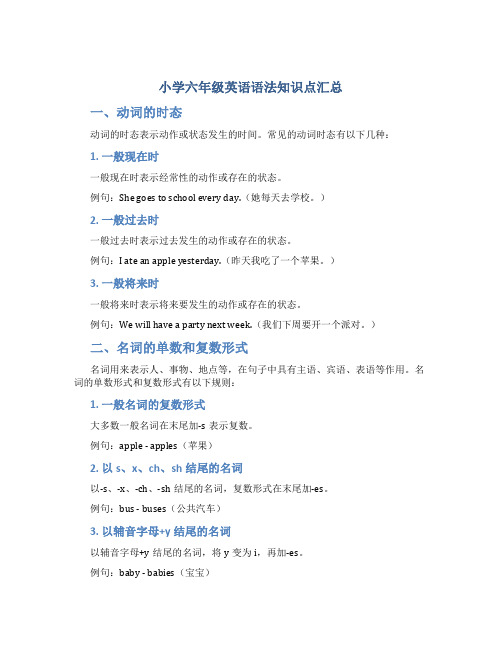
小学六年级英语语法知识点汇总一、动词的时态动词的时态表示动作或状态发生的时间。
常见的动词时态有以下几种:1. 一般现在时一般现在时表示经常性的动作或存在的状态。
例句:She goes to school every day.(她每天去学校。
)2. 一般过去时一般过去时表示过去发生的动作或存在的状态。
例句:I ate an apple yesterday.(昨天我吃了一个苹果。
)3. 一般将来时一般将来时表示将来要发生的动作或存在的状态。
例句:We will have a party next week.(我们下周要开一个派对。
)二、名词的单数和复数形式名词用来表示人、事物、地点等,在句子中具有主语、宾语、表语等作用。
名词的单数形式和复数形式有以下规则:1. 一般名词的复数形式大多数一般名词在末尾加-s表示复数。
例句:apple - apples(苹果)2. 以s、x、ch、sh结尾的名词以-s、-x、-ch、-sh结尾的名词,复数形式在末尾加-es。
例句:bus - buses(公共汽车)3. 以辅音字母+y结尾的名词以辅音字母+y结尾的名词,将y变为i,再加-es。
例句:baby - babies(宝宝)三、形容词的比较级和最高级形容词用来描述或修饰名词。
形容词的比较级和最高级有以下形式:1. 比较级的构成形容词比较级的构成通常在词尾加-er。
例句:tall - taller(高)2. 最高级的构成形容词最高级的构成通常在词尾加-est。
例句:tall - tallest(最高的)四、冠词的用法冠词用来修饰名词,有三个基本形式:不定冠词a/an、定冠词the和零冠词。
1. 不定冠词a/an不定冠词a/an用来表示泛指的意思,在单数名词前用a,在以辅音音素开头的单数名词前用an。
例句:a car(一辆汽车);an apple(一个苹果)2. 定冠词the定冠词the用来表示特指的意思,在特定的名词前使用。
小学英语六年级重要知识点
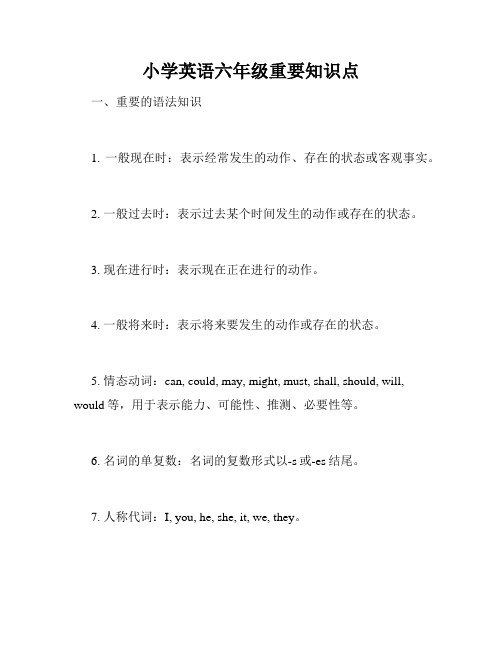
小学英语六年级重要知识点一、重要的语法知识1. 一般现在时:表示经常发生的动作、存在的状态或客观事实。
2. 一般过去时:表示过去某个时间发生的动作或存在的状态。
3. 现在进行时:表示现在正在进行的动作。
4. 一般将来时:表示将来要发生的动作或存在的状态。
5. 情态动词:can, could, may, might, must, shall, should, will, would等,用于表示能力、可能性、推测、必要性等。
6. 名词的单复数:名词的复数形式以-s或-es结尾。
7. 人称代词:I, you, he, she, it, we, they。
8. 形容词的比较级和最高级:通过在形容词前加-er和-est或者在前面加more和most来构成。
9. 反义词/近义词:表示相反意义或接近的词语。
二、重要的词汇和短语1. 数字:千、百、十等数字的读法及运算。
2. 季节和月份:spring, summer, autumn, winter;January, February, March, April, May, June, July, August, September, October, November, December。
3. 食物和饮料:apple, banana, milk, bread, rice, water等。
4. 动物:dog, cat, bird, fish, elephant, tiger, lion, giraffe等。
5. 家庭成员:father, mother, brother, sister, grandparents等。
6. 学科和学校设施:Chinese, English, math, science, school, library, classroom等。
三、重要的句型和对话1. 日常问候用语:如"How are you?" "What's your name?"等。
六年级英语知识点语法总结

六年级英语知识点语法总结英语语法是学习英语的基础,掌握好语法规则对于英语学习的进步至关重要。
下面是六年级英语知识点语法的总结,希望能对大家的学习有所帮助。
一、词汇知识1. 名词(Noun):名词是表示人、事物、地方或概念的词。
如:book(书)、pen(笔)等。
2. 形容词(Adjective):形容词用来描述名词的特征。
如:red (红色的)、tall(高的)等。
3. 动词(Verb):动词用来表示行为或状态。
如:run(跑)、play(玩)等。
4. 代词(Pronoun):代词用来替代名词。
如:he(他)、she (她)等。
5. 副词(Adverb):副词用来修饰动词、形容词或其他副词。
如:quickly(快速地)、very(非常)等。
二、句子结构1. 主语(Subject)和谓语(Predicate):主语是句子中的主要部分,谓语用来说明主语的动作、状态。
如:I like English.(我喜欢英语。
)2. 宾语(Object):宾语接在动词后面,表示动作的承受者或作用对象。
如:She is reading a book.(她在看书。
)3. 定语(Attributive):定语一般放在名词前面,用来限定或修饰名词。
如:a beautiful flower(一朵漂亮的花)。
4. 状语(Adverbial):状语用来修饰动词、形容词、副词或整个句子。
如:He speaks English fluently.(他英语讲得很流利。
)三、时态和语态1. 一般现在时(Simple Present Tense):表示经常或习惯性的动作或状态。
如:I go to school every day.(我每天去上学。
)2. 一般过去时(Simple Past Tense):表示过去发生的动作或状态。
如:They visited their grandparents last weekend.(他们上周末去拜访了他们的祖父母。
六年级英语语法知识点总结
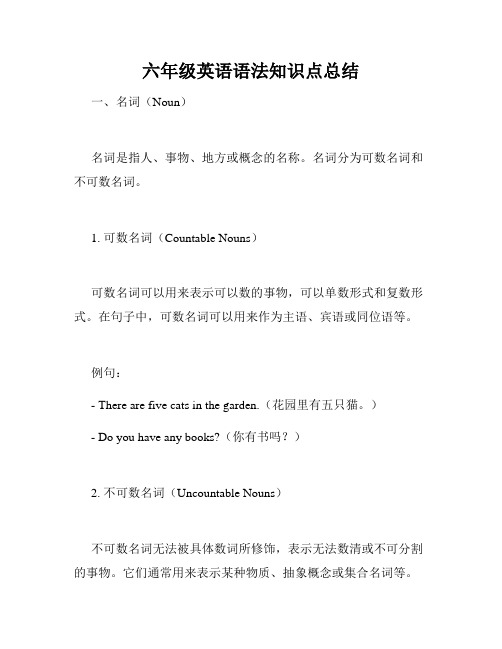
六年级英语语法知识点总结一、名词(Noun)名词是指人、事物、地方或概念的名称。
名词分为可数名词和不可数名词。
1. 可数名词(Countable Nouns)可数名词可以用来表示可以数的事物,可以单数形式和复数形式。
在句子中,可数名词可以用来作为主语、宾语或同位语等。
例句:- There are five cats in the garden.(花园里有五只猫。
)- Do you have any books?(你有书吗?)2. 不可数名词(Uncountable Nouns)不可数名词无法被具体数词所修饰,表示无法数清或不可分割的事物。
它们通常用来表示某种物质、抽象概念或集合名词等。
例句:- I need some information.(我需要一些信息。
)- Would you like some water?(你要喝些水吗?)二、代词(Pronoun)代词是用来代替名词的词语,它可以使语言更加简洁明了。
常见的代词包括人称代词、物主代词、指示代词、反身代词等。
1. 人称代词(Personal Pronouns)人称代词用来代替人或事物的主称。
根据人称的不同,人称代词分为第一人称、第二人称和第三人称。
例句:- I am a student.(我是一名学生。
)- She is my sister.(她是我的姐姐。
)2. 物主代词(Possessive Pronouns)物主代词用来表示所属关系或所有权。
它们可以代替名词,并表示该名词所属的人或事物。
例句:- This book is mine.(这本书是我的。
)- The cat is theirs.(那只猫是他们的。
)3. 指示代词(Demonstrative Pronouns)指示代词用来指示特定的人或事物。
它们可以代替名词,并指出所指的人或事物。
例句:- This is my bag.(这是我的书包。
)- Those are my shoes.(那些是我的鞋子。
六年级英语语法与句型知识点

1. 一般现在时:句子中的主语用第三人称单数时,动词需加s或es。
如:She likes ice cream.2. 一般过去时:句子中的主语要用过去式动词。
如:He played football yesterday.3. 现在进行时:由“be + 动词的ing形式”构成,表示当前正在进行的动作。
如:They are watching TV now.4. 一般将来时:表示将来发生的动作或存在的状态。
如:I will go to the park tomorrow.5. 祈使句:用来表达请求、命令、劝告等,一般省略主语。
如:Do your homework now.6. 定义性从句:用来对主句中的名词进行解释或给出相关信息。
如:The book that is on the table is mine.7. 状语从句:用来表示时间、地点、原因、条件等,常用连词如when、where、because、if等引导。
如:I will go to bed when Ifinish my homework.8. 三单形式:动词的第三人称单数形式,一般在动词原形后加s、es。
如:He reads books every day.9. 比较级与最高级:用于比较两个事物的大小、程度等。
比较级在两个事物之间进行比较,最高级表示在三个以上的事物之间进行比较。
如:This book is longer than that one. This is the tallest buildingin the city.10. 反意疑问句:附在陈述句结尾,表示征求对方的意见或肯定。
一般与陈述句的人称、时态保持一致。
如:You like swimming, don't you?11. 疑问句:用于询问信息,一般由助动词、系动词或疑问词引导。
如:Can you swim? What is your name?12. There be句型:表示处存在人或物的状态。
英语六年级语法知识点
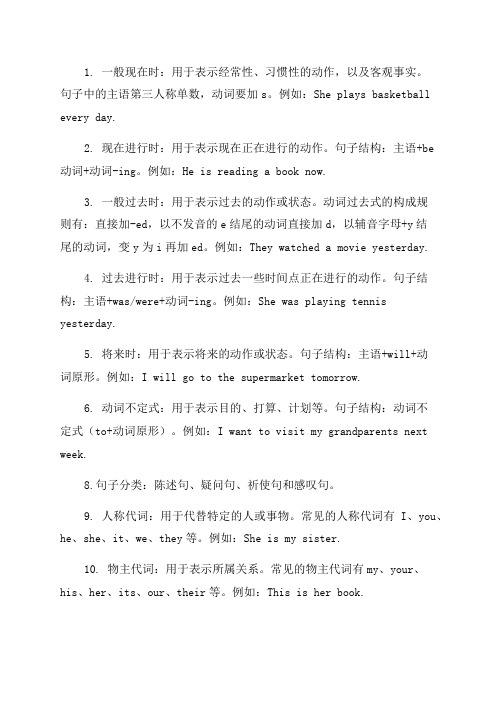
1. 一般现在时:用于表示经常性、习惯性的动作,以及客观事实。
句子中的主语第三人称单数,动词要加s。
例如:She plays basketball every day.2. 现在进行时:用于表示现在正在进行的动作。
句子结构:主语+be动词+动词-ing。
例如:He is reading a book now.3. 一般过去时:用于表示过去的动作或状态。
动词过去式的构成规则有:直接加-ed,以不发音的e结尾的动词直接加d,以辅音字母+y结尾的动词,变y为i再加ed。
例如:They watched a movie yesterday.4. 过去进行时:用于表示过去一些时间点正在进行的动作。
句子结构:主语+was/were+动词-ing。
例如:She was playing tennis yesterday.5. 将来时:用于表示将来的动作或状态。
句子结构:主语+will+动词原形。
例如:I will go to the supermarket tomorrow.6. 动词不定式:用于表示目的、打算、计划等。
句子结构:动词不定式(to+动词原形)。
例如:I want to visit my grandparents next week.8.句子分类:陈述句、疑问句、祈使句和感叹句。
9. 人称代词:用于代替特定的人或事物。
常见的人称代词有I、you、he、she、it、we、they等。
例如:She is my sister.10. 物主代词:用于表示所属关系。
常见的物主代词有my、your、his、her、its、our、their等。
例如:This is her book.11. 形容词比较级和最高级:用于表示两个以上事物的比较。
形容词的比较级通常在词尾加-er,最高级在词尾加-est,部分形容词需加more和most。
例如:He is taller than his brother.12. 数词:用于表示数量的词汇,分为基数词和序数词。
六年级英语语法点整理

六年级英语语法点整理
以下是六年级英语的一些主要语法点:
1. 现在进行时:表示正在发生的动作。
结构为“be (am/is/are) + -ing”形式。
2. 一般现在时:描述日常习惯、能力和事实。
结构为“动词原形 + (第三人称单数时加-s/-es)。
3. 一般过去时:描述过去的事件或动作。
结构为“动词的过去式”。
4. 一般将来时:描述将来会发生的事件或动作。
结构为“will + 动词原形”或“be going to + 动词原形”。
5. 形容词的比较级和最高级:形容词用来描述名词的特性,比较级和最高级表示比较关系。
6. 副词的比较级和最高级:副词用来描述动词、形容词或其他副词的强度、频率或时间。
7. 介词:表示名词或代词与句子其他部分之间的关系,如“在、到、从、对于、通过”等。
8. 代词:代替名词或名词短语,例如“我、你、他、她、它、我们、他们”等。
9. 冠词:用在名词前,表示该名词的种类。
例如“a”用于元音发音开头的单词,“an”用于元音发音开头的单词,“the”用于特指。
10. 连词:用于连接词、短语或从句,表示它们之间的关系,如“和、但是、因为、所以”等。
以上是六年级英语的一些主要语法点,通过掌握这些语法点,学生可以更好地理解英语句子结构,提高阅读和写作能力。
六年级英语语法点整理

六年级英语语法点整理1.人称代词主格:I we you she he it they宾格:me us you her him it them形容词性物主代词:my our your her his its their名词性物主代词:mine ours yours hers his its theirs 2.形容词和副词的比较级(1) 一般在形容词或副词后+erolder taller longer stronger, etc(2) 多音节词前+moremore interesting, etc.(3) 双写最后一个字母,再+erbigger fatter, etc.(4) 把y变i,再+erheavier, earlier(5) 不规则变化:well-better, much/many-more, etc.3.可数词的复数形式Most nouns + s a book –booksNouns ending in a consonant +y - y+ ies a story—storiesNouns ending in s, sh, ch or x + es a glass—glasses a watch-watches Nouns ending in o +s or +es a piano—pianos a mango—mangoes Nouns ending in f or fe - f or fe +ves a knife –knives a shelf-shelves 4.不可数名词(单复数形式不变)bread, rice, water ,juice etc.5. 缩略形式I’m = I am you’re = you are she’s = she is he’s = he isit’s = it is who’s =who is can’t =can not isn’t=is not etc6. a/ana book, a peachan egg an hour7. Preposition:on, in ,in front of, between, next to, near, beside, at, behind.表示时间:at six o’clock, at Christmas, at breakfast on Monday on 15th July On National Dayin the evening in December in winter8. 基数词和序数词one –first two-second twenty-twentieth9. Some /anyI have some toys in my bedroom.Do you have any brothers or sisters?10. be 动词(1) Basic form: am/are/is(2) 肯定和否定句I am(not) from London.My eyes are(not) small.My hair is(not) long.(3)一般疑问句:Am I a Chniese? Yes, you are. No, you aren’t. Are they American? Yes, they are. No, they aren’t.Is the cat f at? Yes, it is. No, it isn’t.11. there be 结构肯定句:There is a …There are …一般疑问句:Is there …? Yes, there is./ No, there isn’t.Are there…? Yes, there are. /No, there aren’t.否定句:There isn’t …. There aren’t….12. 祈使句Sit down pleaseDon’t s it down, please.13. 现在进行时.通常用“now”.形式:be + verb +ingeg: I am(not) doing my homework.You/We/They are(not) reading.He/She/It is(not) eating.动词—ing 的形式Most verbs +ing walk—walkingVerbs ending in e -e + ing come—comingShort verbs ending in a vowel + a consonant run –running swim—swimming 14 一般现在时。
- 1、下载文档前请自行甄别文档内容的完整性,平台不提供额外的编辑、内容补充、找答案等附加服务。
- 2、"仅部分预览"的文档,不可在线预览部分如存在完整性等问题,可反馈申请退款(可完整预览的文档不适用该条件!)。
- 3、如文档侵犯您的权益,请联系客服反馈,我们会尽快为您处理(人工客服工作时间:9:00-18:30)。
一、of sb.与for sb.的区别
(1)of sb.“对于(某人)”,用于It is +adj. +of sb. to do sth.句型中,形容词为clever, kind, nice等描述人物性格特征的词,of后的人物与形容词有主表关系。
Because he was tired, he couldn’t walk there.
=He was tired ,so he couldn’t walk there.
因为他累了,所以他不能走到那儿了。
2、(al)thouthg(虽然),but (但是)不能同时出现在一个句子里,只能用其一。但thouthg和yet能够同时出现在一个句子里(yet用作副词)
六年级英语语法知识点整理
一、a number of ,the number of
a number of 意思是“很多”,相当于a lot of ; the number of意思是“……的数目,……的数量”,当它作主语时,谓语动词用单数形式。
A number of students like playing computer games.
hundreds/thousands/millions/billions swimming in summer in Dalian.
A、Thousands B、Thousand of C、Thousands of D、Thousand
2. __the students will take part in this English speech contest.
(2)for sb.“对于(某人)”,用于It is +adj. +for sb. to do sth.句型中, 形容词为easy, important等不描述人物性格特征的词,for后的人物与形容词没有主表关系。
二、不能同时出现在一个句子中的连词
1、because(因为),so(所以)不能同时出现在一个句子里,只能用其一。
很多学生喜欢玩电脑游戏。
The number of the students is about 1500 in our school.
我们学校学生的人数大约是1500。
二、基数词变序数词助记歌。
基变序,有规律,末尾加上th;一、二、三特殊记,八加h ,九去e ,ve要用f替;以e结尾变ie,后跟th莫忘记。要想表示几十几,只变个位就能够。
Thought he was tired, he still worked hard.
=He was tired, but he still worked hard.
虽然他很累,但他仍然努力工作。
特殊变化:one—first ,two—second ,three—third ,five—fifth ,
nine—ninth ,twelve—twelfth ,forty—fortieth ,
eight-nine—eighty-ninth
三、概数(略数)表达法
数词+hundred/thousand/million/billion+名词复数
